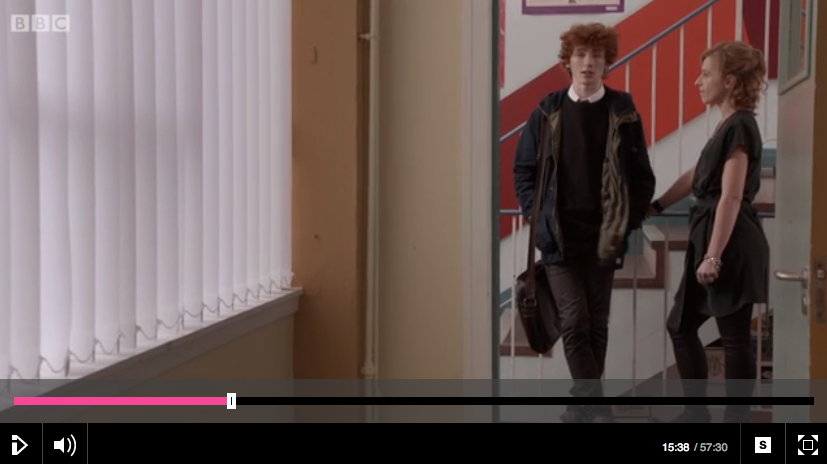What Was the Shooting Style?
As a scene opens, I've noticed that the camera pans and tracks slowly to help introduce the setting. This is now quite a common shooting technique on modern TV (BBC 3 itself generally uses it quite often in its documentaries, such as one of the latest documentaries 'Growing up Poor'.).
Nonetheless, some scenes in Waterloo Road now have shots where the camera pans around a door or reveals its self as if the camera was hiding. This is often used to introduce not only the setting but also as if it is intruding when there are characters within the shot.
This constant panning/tracking generally keeps every shot running - there are actually very few still shots. This to me is very effective as it is frequently keeping the pace of the narrative moving, which generally just seems more effective than still shots if you have a film which has a lot of moving going on (which would work well for our cooking story).
Detailed Example
Print screened from BBC Iplayer, you can see an example of how the camera tracks and almost seems invasive. The first image (above) shows the character in the corner of the film - they haven't been positioned to be the main focus as the camera is almost trying to hear in on their conversation (which is parallel to the narrative, as the two characters are talking about a family dispute).
Nonetheless, the image below is the last couple of frames before the camera switches shot. When looking at the time on the IPlayer, you can see that this shot is around 13 seconds long - quite a long shot considering there isn't much movement within the scene.
Also when comparing the two images, you can roughly judge how slow the track has been - the bottom image isn't that far past the blue wall you can see on the top image, which when working out you can probably walk from the top to the bottom image in 2-3 footsteps. This means that the camera has moved around 13 seconds and only moved around 2-3 footsteps. Which in my opinion, the slow tracking fits perfectly with the narrative and allows the narrative to keep the drama being built up in the programme to continuously flow, as you rarely see a still shot (usually when you do it is at the climax, once all the drama is being released/has been released).
How Can This Be Adapted To Our Cooking Story?
Now I know this shooting style seems intrusive as the camera may seem like it's hiding, however I thought this could be adapted into our cooking story.
For example, whilst the food is cooking, the camera could be panning behind say an iconic kitchen item to view to see our reporter preparing or cooking food e.g. the camera could pan behind a say an onion to then view to see our reporter preparing a meal.
This would work well with our cooking story as our story is generally very fast-paced due to the audience having to learn the steps of cooking. Therefore, if we deliberately keep the camera constantly moving then it may work in a way to keep the audience thinking and staying motivated swell, therefore helping them to learn and more importantly keeping them engaged and interested with our story.
Therefore, I will try to incorporate this shooting style with our cooking style. Not so much on the significance of the tracking/panning, but more importantly trying to keep the camera constantly moving so that we have little still shots, making the story seem fast paced and keeping the narrative pace flowing.
FILM LIKE BBC 1 WATERLOO ROAD - camera constantly panning and tracking, keeping the shots moving.



0 comments:
Post a Comment